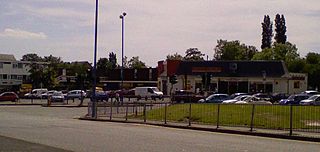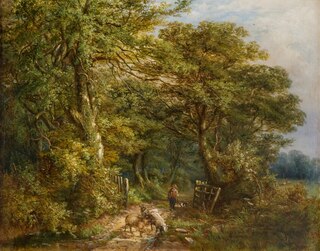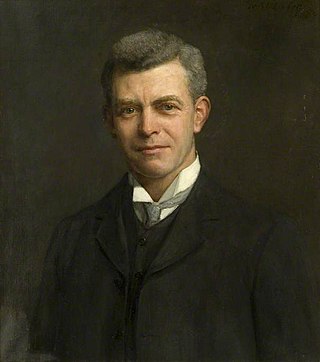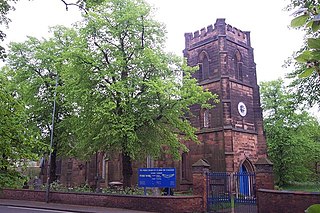
Great Barr is a large and loosely defined area to the north-west of Birmingham, in the county of the West Midlands, England. The area was historically in Staffordshire, and the parts now in Birmingham were once known as Perry Barr, which is still the name of an adjacent Birmingham district. Other parts still known as Great Barr are now in the Metropolitan Boroughs of Walsall and Sandwell.

Water Orton is a village and civil parish in the North Warwickshire borough of Warwickshire in the West Midlands, England near the River Tame. It is located between Castle Bromwich and Coleshill, and borders the West Midlands metropolitan county boundary to the north, west and south. At the 2001 Census, the population was 3,573, falling to 3,444 at the 2011 Census. In the 2021 Census the population slightly rose to 3,487.

St Mary's Church, Handsworth, also known as Handsworth Old Church, is a Grade II* listed Anglican church in Handsworth, Birmingham, England. Its ten-acre (4 hectare) grounds are contiguous with Handsworth Park. It lies just off the Birmingham Outer Circle, and south of a cutting housing the site of the former Handsworth Wood railway station. It is noteworthy as the resting place of famous progenitors of the industrial age, and has been described as the "Cathedral of the Industrial Revolution".

Berkswell is a village and civil parish in the Metropolitan Borough of Solihull, county of West Midlands, England. Historically in Warwickshire, Berkswell is situated in the rural east of the borough, approximately 2 miles (3.2 km) west of the western city boundary of Coventry, at Eastern Green. It is situated about 6.5 miles (10.5 km) west of Coventry city centre, 8.5 miles (13.7 km) east of central Solihull, 2.5 miles (4.0 km) south of Meriden and 2 miles (3.2 km) north of Balsall Common.

Hamstead is an area straddling the border of Birmingham and Sandwell, England, between Handsworth Wood and Great Barr, and adjacent to the Sandwell Valley area of West Bromwich. Hamstead Colliery was worked from the 19th century to the 1960s, with much housing built for the miners. Today the area is still referred to as Hamstead Village.

Holland William Hobbiss, was an English architect in the Birmingham area. He traded under the names Holland W. Hobbiss and Partners and Holland W. Hobbiss and M. A. H. Hobbiss.
Richard Charles Hussey (1806–1887), often referred to as R. C. Hussey, was a British architect. He was in partnership with Thomas Rickman from 1835, whose practice he assumed in 1838 with the latter's failing health; Rickman died on 4 January, 1841.
Benjamin Ferrey FSA FRIBA was an English architect who worked mostly in the Gothic Revival.

Sir Charles Archibald Nicholson, 2nd Baronet, was an English architect and designer who specialised in ecclesiastical buildings and war memorials. He carried out the refurbishments of several cathedrals, the design and build of over a dozen new churches, and the restoration of many existing, medieval parish churches.

St Bartholomew's Church, Edgbaston, also known as Edgbaston Old Church, is a parish church in the Church of England in Edgbaston, Birmingham.

Tysoe is a civil parish in the Stratford-on-Avon District of Warwickshire, England. The parish is on the boundary with Oxfordshire, about 7+1⁄2 miles (12 km) northwest of Banbury. The parish includes the contiguous villages of Middle and Upper Tysoe and the separate hamlet of Lower Tysoe. The 2011 census recorded the parish population as 1,143.

21 Yateley Road, Edgbaston, Birmingham, England is a house built in 1899. It was designed by Herbert Tudor Buckland as his own home, and built by his partnership, Buckland & Haywood-Farmer, which constructed some of the best housing in the Birmingham suburbs in the early 20th century. The architectural style is Arts and Crafts and the house is a Grade I listed building.

Pillerton Hersey is a village and civil parish about 5.5 miles (9 km) north of Shipston-on-Stour in Warwickshire, England. The village is on a stream that flows northwest to join the River Dene. The 2011 Census recorded the parish's population as 170.

Church of SS Mary and Ambrose, Edgbaston is a Grade II listed parish church in the Church of England in Birmingham.

St Benedict's Church, Bordesley is a Church of England parish church in Hob Moor Road, Bordesley, West Midlands, England, about 2+1⁄2 miles (4 km) east of Birmingham city centre. It is an early 20th-century church in Byzantine Revival style and is Grade II listed.

St John the Evangelist's Church, Perry Barr is a Grade II listed parish church in the Church of England in the Perry Barr area of Birmingham, England.

St Silas' Church, Lozells is a Grade II listed redundant parish church in the Church of England in Birmingham now used by the Triumphant Church of God.
St James' Church is a parish church in the Church of England in Aston, Birmingham, England.
Alexandra Mary, Lady Wedgwood, is an English architectural historian and expert on the work of Augustus Pugin. She is the patron of the Pugin Society and the former architectural archivist of the House of Lords.

The Homestead, 25 Woodbourne Road, Edgbaston, Birmingham, England is a house built in 1897. It was designed by Charles Bateman, and built by James Smith & Son. The architectural style is Arts and Crafts and the house is a Grade I listed building. The garden wall and gate piers facing Woodbourne Road have a separate Grade I listing. The Homestead remains a private residence.




















